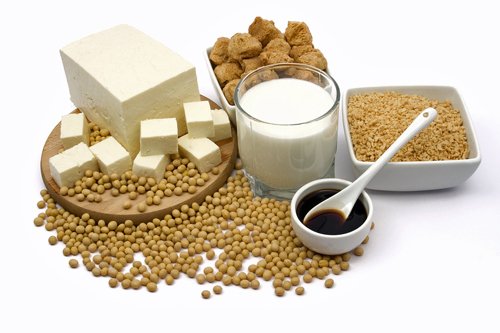SOY PROTEIN
Soybeans are not only higher in protein than other legumes but the quality of soy protein is superior to that of other plant proteins and relatively similar to that of animal proteins [1]. Soybeans are one of the few vegetarian sources of total protein containing all of the essential amino acids required in the human diet. The recommended intake of dietary whole soy protein is 25 g per day, and 40 to 80 mg per day for soy isoflavones [2].
The Properties of Soy Protein
Gains in Muscle Mass and Strength in Response to Resistance Exercise
Plant proteins such as soy protein may have a number of advantages over animal protein, such as lowering blood cholesterol levels; however, a general view within the sports nutrition community is that animal proteins and whey protein, in particular, are more effective in building muscle in response to resistance exercise training (RET) [1].
According to the current meta-analysis, whey or soy protein supplements during RET increase lean body mass (LBM) and strength in a comparable manner. A recently published meta-analysis by Morton et al. (2017), which included 49 intervention studies involving 1,863 participants, examined the effect of protein supplementation on changes in muscle mass and strength in conjunction with resistance training. The authors found that consumption of protein supplements alongside RET resulted in greater increases in fat-free mass and muscle strength than resistance training alone and that the effect of protein supplementation was more pronounced among trained participants and attenuated with increasing age. In their analysis, Morton et al. (2017) did not distinguish among protein sources, but rather analyzed the effect of protein versus no protein supplementation on effect size [1].
The meta-regression also conducted by these authors, including 15 studies, which investigated the influence of protein source (soy vs. whey) on change in LBM or strength, concluded it is potentially a very minor determinant (Morton et al., 2017). In the current study, two meta-analyses were conducted: one compared soy protein with whey protein and other compared soy protein with all other animal proteins. The present results both confirm the observation by Morton et al. (2017) and extend it by showing differences do not exist not only between soy protein and whey but also between soy protein and animal protein in general [1].
Soy protein supplements can be viewed as sources of protein suitable for building strength and increasing lean tissue in response to RET. Overall, the results indicate that protein source is not likely an important factor influencing gains in strength and LBM in response to RET. As two dietary principles are moderation and variety, rather than relying on just one source, including soy protein as an option for meeting protein needs for those wanting to increase strength and LBM makes overall nutritional sense [1].
Hot flush in menopause
Soybeans are generally composed of ~35–40% protein, ~20% lipids, ~9% dietary fiber, and ~8.5% moisture based on the dry weight of mature raw seeds [3]. Soybeans contain many biologically active compounds, including saponins, lecithin, phytates, protease inhibitors, phenolic acids, phytosterols, isoflavones, and omega-3 fatty acids. Much of the attention around the active compounds in soy focuses on the isoflavones genistein and daidzein. These two phytoestrogens weakly bind to the estrogen receptors alpha and beta, but preferentially bind to the estrogen receptor beta, where they may act like selective estrogen receptor modulators that can possible reduction of menopausal hot flashes [2].
Effects of Soy Protein on Cardiovascular Disease Risk Factors
Lipid Levels
Elevated low-density lipoprotein (LDL)-cholesterol is a well-established risk factor for coronary heart disease (CHD). Soy protein was first formally recognized by the US Food and Drug Administration (FDA) in 1999. The FDA established 25 g/day soy protein as the threshold intake for cholesterol reduction. Twenty-five g is certainly more soy protein than is consumed by most Asians but through a combination of soy foods this threshold can be relatively easily met [3].
In general, about 20% of individuals whose cholesterol levels are elevated do not respond to dietary changes. So it is not surprising, especially when considering that many interventions involved small participant numbers and that the effect of soy protein is modest, that not all studies reported soy protein statistically significantly lowered circulating cholesterol levels. But there is study determined that soy protein statistically significantly lowers LDL-cholesterol by approximately 4% to 6%. Evidence indicates that the decrease in LDL-cholesterol in response to soy protein is greater in hypercholesterolemic compared to normocholesterolemic individuals. In addition to lowering LDL-cholesterol, soy protein also modestly lowers circulating triglyceride levels (~5%) and raises high-density-lipoprotein (HDL)-cholesterol levels (~1% – 3%) [3].
Contraindications, Adverse effects, and interactions
Gastrointestinal symptoms (e.g., diarrhea), followed by menstrual complaints (e.g., prolonged periods, amenorrhea) were the most commonly reported adverse events. others included headache, dizziness, and musculoskeletal complaints [2].
Soy allergy (often leading to bloody diarrhea) is reported in about 1 percent of infants on soy formulas and usually resolves by three years of age, when most of these children begin to tolerate soy products. Allergy to soy in adults is uncommon and estimated to occur in about 0.2 percent of the U.S. population. Anaphylaxis has been reported with soy, but is rare [2].
References
- Messina M, Lynch H, Dickinson J, Reed K. No Difference Between the Effects of Supplementing with Soy Protein Versus Animal Protein on Gains in Muscle Mass and Strength in Response to Resistance Exercise. International Journal of Sport Nutrition and Exercise Metabolism. 2018 [cited 2022 September 7]; 28: 674-85. Available form: https://journals.humankinetics.com/view/journals/ijsnem/28/6/article-p674.xml
- Michelfelder A. Soy: a complete source of protein. American Family Physician. 2009 [cited 2022 September 7]; 79: 43-7. Available form: https://www.aafp.org/pubs/afp/issues/2009/0101/p43.html
- Messina M. Soy and Health Update: Evaluation of the Clinical and Epidemiologic Literature. Nutrients. 2016 [cited 2022 September 7]; 8: 1-42. Available form: https://www.ncbi.nlm.nih.gov/pmc/articles/PMC5188409/

